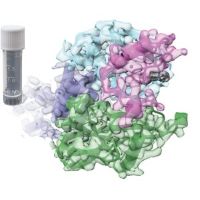Specification
| Description | Recombinant protein from the full-length sequence of Homo sapiens natriuretic peptide A (NPPA) (NM_006172). |
| Organism | Homo sapiens (Human) |
| Expression Host | Human Cells |
| Tag Info | His or DYKDDDDK. Please contact us if you need further information or require specific designed tag. |
| Purity | Greater than 90% by SDS-PAGE gel |
| Uniprot ID | P01160 |
| Entry Name | ANF_HUMAN |
| Gene Names | NPPA ANP PND |
| Alternative Gene Names | ANP PND |
| Alternative Protein Names | Natriuretic peptides A (Atrial natriuretic factor prohormone) (proANF) (Atrial natriuretic peptide prohormone) (preproANP) (proANP) (Atriopeptigen) (Cardiodilatin) (CDD) (preproCDD-ANF) [Cleaved into: Long-acting natriuretic peptide (LANP) (Long-acting natriuretic hormone) (LANH) (Pro atrial natriuretic factor 1-30) (proANF 1-30) (Pro atrial natriuretic peptide 1-30) (proANP 1-30); Vessel dilator (VSDL) (Pro atrial natriuretic factor 31-67) (proANF 31-67) (Pro atrial natriuretic peptide 31-67) (proANP 31-67); Kaliuretic peptide (KP) (Pro atrial natriuretic factor 79-98) (proANF 79-98) (Pro atrial natriuretic peptide 79-98) (proANP 79-98); Urodilatin (URO) (CDD 95-126) (CDD-ANP (95-126)) (Pro atrial natriuretic peptide 95-126) (proANP 95-126); Auriculin-C (Atrial natriuretic factor 1-33) (ANF 1-33); Auriculin-D (Atrial natriuretic factor 3-33) (ANF 3-33); Atrial natriuretic peptide (ANP) (Alpha-atrial natriuretic peptide) (Alpha-hANP) (Atrial natriuretic factor) (ANF) (CDD-ANF) (CDD-ANP (99-126)) (Cardionatrin) (Pro atrial natriuretic factor 99-126) (proANF 99-126); Auriculin-B (Atrial natriuretic factor 8-33) (ANF 8-33); Auriculin-A; Atriopeptin-1 (Atriopeptin I); Atriopeptin-2 (Atriopeptin II); Atriopeptin-3 (Atriopeptin III)] |
| Application | Antigens, Western, ELISA and other in vitro binding or in vivo functional assays, and protein-protein interaction studies; For research & development use only! |
| Buffer | Purified protein formulated in a sterile solution of PBS buffer, pH7.2, without any preservatives |
| Endotoxin | Endotoxin level is < 0.1 ng/µg of protein (<1EU /µg) |
| Length | 151 |
| Molecular Weight(Da) | 16396 |
| Protein Sequence | (The sequence of expressed protein may have some variation from the sequence shown below. Please contact us for the exact sequence.) MSSFSTTTVSFLLLLAFQLLGQTRANPMYNAVSNADLMDFKNLLDHLEEKMPLEDEVVPPQVLSEPNEEAGAALSPLPEVPPWTGEVSPAQRDGGALGRGPWDSSDRSALLKSKLRALLTAPRSLRRSSCFGGRMDRIGAQSGLGCNSFRY |
Background
| Function | FUNCTION: [Atrial natriuretic peptide]: Hormone that plays a key role in mediating cardio-renal homeostasis, and is involved in vascular remodeling and regulating energy metabolism (PubMed:8653797, PubMed:7595132, PubMed:2825692, PubMed:7720651, PubMed:8087923, PubMed:2532366, PubMed:22307324, PubMed:18835931, PubMed:21672517, PubMed:15741263, PubMed:16875975). Acts by specifically binding and stimulating NPR1 to produce cGMP, which in turn activates effector proteins, such as PRKG1, that drive various biological responses (PubMed:25401746, PubMed:9893117, PubMed:1672777, PubMed:1660465, PubMed:2162527, PubMed:2825692, PubMed:7720651, PubMed:22307324, PubMed:8384600, PubMed:21098034). Regulates vasodilation, natriuresis, diuresis and aldosterone synthesis and is therefore essential for regulating blood pressure, controlling the extracellular fluid volume and maintaining the fluid-electrolyte balance (PubMed:8653797, PubMed:7595132, PubMed:2825692, PubMed:7720651, PubMed:2532366, PubMed:8087923). Also involved in inhibiting cardiac remodeling and cardiac hypertrophy by inducing cardiomyocyte apoptosis and attenuating the growth of cardiomyocytes and fibroblasts (PubMed:16875975). Plays a role in female pregnancy by promoting trophoblast invasion and spiral artery remodeling in uterus, and thus prevents pregnancy-induced hypertension (By similarity). In adipose tissue, acts in various cGMP- and PKG-dependent pathways to regulate lipid metabolism and energy homeostasis (PubMed:22307324, PubMed:18835931, PubMed:21672517, PubMed:15741263). This includes upregulating lipid metabolism and mitochondrial oxygen utilization by activating the AMP-activated protein kinase (AMPK), and increasing energy expenditure by acting via MAPK11 to promote the UCP1-dependent thermogenesis of brown adipose tissue (PubMed:22307324, PubMed:18835931, PubMed:21672517, PubMed:15741263). Binds the clearance receptor NPR3 which removes the hormone from circulation (PubMed:1672777). {ECO:0000250|UniProtKB:P05125, ECO:0000269|PubMed:15741263, ECO:0000269|PubMed:1660465, ECO:0000269|PubMed:1672777, ECO:0000269|PubMed:16875975, ECO:0000269|PubMed:18835931, ECO:0000269|PubMed:21098034, ECO:0000269|PubMed:2162527, ECO:0000269|PubMed:21672517, ECO:0000269|PubMed:22307324, ECO:0000269|PubMed:2532366, ECO:0000269|PubMed:25401746, ECO:0000269|PubMed:2825692, ECO:0000269|PubMed:7595132, ECO:0000269|PubMed:7720651, ECO:0000269|PubMed:8087923, ECO:0000269|PubMed:8384600, ECO:0000269|PubMed:8653797, ECO:0000269|PubMed:9893117}.; FUNCTION: [Long-acting natriuretic peptide]: May have a role in cardio-renal homeostasis through regulation of natriuresis, diuresis, vasodilation, and inhibiting aldosterone synthesis (PubMed:8653797, PubMed:7955907, PubMed:8087923, PubMed:2825692, PubMed:7595132, PubMed:2532366). In vitro, promotes the production of cGMP and induces vasodilation (PubMed:2825692). May promote natriuresis, at least in part, by enhancing prostaglandin E2 synthesis resulting in the inhibition of renal Na+-K+-ATPase (PubMed:7720651). However reports on the involvement of this peptide in mammal blood volume and blood pressure homeostasis are conflicting; according to a report, in vivo it is not sufficient to activate cGMP and does not inhibit collecting duct transport nor effect diuresis and natriuresis (By similarity). Appears to bind to specific receptors that are distinct from the receptors bound by atrial natriuretic peptide and vessel dilator (PubMed:2162527, PubMed:2825692). Possibly enhances protein excretion in urine by decreasing proximal tubular protein reabsorption (PubMed:11145122). {ECO:0000250|UniProtKB:P01161, ECO:0000269|PubMed:11145122, ECO:0000269|PubMed:2162527, ECO:0000269|PubMed:2532366, ECO:0000269|PubMed:2825692, ECO:0000269|PubMed:7595132, ECO:0000269|PubMed:7720651, ECO:0000269|PubMed:7955907, ECO:0000269|PubMed:8087923, ECO:0000269|PubMed:8653797}.; FUNCTION: [Vessel dilator]: May have a role in cardio-renal homeostasis through regulation of natriuresis, diuresis, and vasodilation (PubMed:8653797, PubMed:7955907, PubMed:8087923, PubMed:2532366, PubMed:7595132). In vitro, promotes the production of cGMP and induces vasodilation (PubMed:2825692). May promote natriuresis, at least in part, by enhancing prostaglandin E2 synthesis resulting in the inhibition of renal Na+-K+-ATPase (PubMed:7720651, PubMed:7595132). However reports on the involvement of this peptide in mammal blood volume and blood pressure homeostasis are conflicting; according to a report it is not sufficient to activate cGMP and does not inhibit collecting duct transport nor effect diuresis and natriuresis (PubMed:7831500). Appears to bind to specific receptors that are distinct from the receptors bound by the atrial natriuretic and long-acting natriuretic peptides (PubMed:2162527, PubMed:2825692). Possibly functions in protein excretion in urine by maintaining the integrity of the proximal tubules and enhancing protein excretion by decreasing proximal tubular protein reabsorption (PubMed:11145122). {ECO:0000269|PubMed:11145122, ECO:0000269|PubMed:2162527, ECO:0000269|PubMed:2532366, ECO:0000269|PubMed:2825692, ECO:0000269|PubMed:7595132, ECO:0000269|PubMed:7720651, ECO:0000269|PubMed:7831500, ECO:0000269|PubMed:7955907, ECO:0000269|PubMed:8087923, ECO:0000269|PubMed:8653797}.; FUNCTION: [Kaliuretic peptide]: May have a role in cardio-renal homeostasis through regulation of diuresis and inhibiting aldosterone synthesis (PubMed:8087923, PubMed:2825692, PubMed:7595132). In vitro, promotes the production of cGMP and induces vasodilation (PubMed:2825692). May promote natriuresis, at least in part, by enhancing prostaglandin E2 synthesis resulting in the inhibition of renal Na+-K+-ATPase (PubMed:7720651, PubMed:7595132). May have a role in potassium excretion but not sodium excretion (natriuresis) (PubMed:8087923). Possibly enhances protein excretion in urine by decreasing proximal tubular protein reabsorption (PubMed:11145122). {ECO:0000269|PubMed:11145122, ECO:0000269|PubMed:2825692, ECO:0000269|PubMed:7595132, ECO:0000269|PubMed:7720651, ECO:0000269|PubMed:8087923}.; FUNCTION: [Urodilatin]: Hormone produced in the kidneys that appears to be important for maintaining cardio-renal homeostasis (PubMed:8351194, PubMed:8853410, PubMed:8779891). Mediates vasodilation, natriuresis and diuresis primarily in the renal system, in order to maintain the extracellular fluid volume and control the fluid-electrolyte balance (PubMed:2528951, PubMed:8351194, PubMed:8853410, PubMed:8779891). Specifically binds and stimulates cGMP production by renal transmembrane receptors, likely NPR1 (PubMed:8384600, PubMed:9893117). Urodilatin not ANP, may be the natriuretic peptide responsible for the regulation of sodium and water homeostasis in the kidney (PubMed:8779891, PubMed:8384600). {ECO:0000269|PubMed:2528951, ECO:0000269|PubMed:8351194, ECO:0000269|PubMed:8384600, ECO:0000269|PubMed:8779891, ECO:0000269|PubMed:8853410, ECO:0000269|PubMed:9893117}.; FUNCTION: [Auriculin-D]: May have a role in cardio-renal homeostasis through regulation of natriuresis and vasodilation. In vivo promotes natriuresis and in vitro, vasodilates renal artery strips. {ECO:0000250|UniProtKB:P01161}.; FUNCTION: [Auriculin-B]: May have a role in cardio-renal homeostasis through regulation of natriuresis and vasodilation. In vivo promotes natriuresis and in vitro, vasodilates renal artery strips. {ECO:0000250|UniProtKB:P01161}.; FUNCTION: [Auriculin-A]: May have a role in cardio-renal homeostasis through regulation of regulation of natriuresis and vasodilation. In vivo promotes natriuresis. In vitro, vasodilates intestinal smooth muscle but not smooth muscle strips. {ECO:0000250|UniProtKB:P01161}.; FUNCTION: [Atriopeptin-2]: May have a role in cardio-renal homeostasis through regulation of natriuresis and vasodilation. In vivo promotes natriuresis. In vitro, selectively vasodilates intestinal and vascular smooth muscle strips. {ECO:0000250|UniProtKB:P01161}.; FUNCTION: [Atriopeptin-1]: May have a role in cardio-renal homeostasis through regulation of natriuresis and vasodilation. In vivo promotes natriuresis. In vitro, selectively vasodilates intestinal smooth muscle but not vascular smooth muscle strips. {ECO:0000250|UniProtKB:P01161}. |
| Pathway | |
| Protein Families | Natriuretic peptide family |
| Tissue Specificity | [Urodilatin]: Detected in the kidney distal tubular cells (at protein level) (PubMed:9794555, PubMed:8384600). Present in urine (at protein level) (PubMed:2972874, PubMed:9794555, PubMed:8351194, PubMed:8779891). {ECO:0000269|PubMed:2972874, ECO:0000269|PubMed:8351194, ECO:0000269|PubMed:8384600, ECO:0000269|PubMed:8779891, ECO:0000269|PubMed:9794555}.; TISSUE SPECIFICITY: [Atrial natriuretic peptide]: Detected in atrial and ventricular plasma samples, and in adipocytes (at protein level) (PubMed:22291141, PubMed:21672517). Detected in urine in one study (PubMed:8351194). However, was not detected in urine in another study (PubMed:7984506). In the brain, predominantly expressed in the gray matter with very weak expression in the white matter (at protein level) (PubMed:30534047). Localizes to astrocyte-like structures throughout the white matter, and in the cerebral vessels detected in the leptomeningeal and parenchymal vessels, and endothelium and smooth muscle layers (at protein level) (PubMed:30534047). Relatively low levels of expression in the kidneys compared to urodilatin (at protein level) (PubMed:9794555, PubMed:8384600). {ECO:0000269|PubMed:21672517, ECO:0000269|PubMed:22291141, ECO:0000269|PubMed:30534047, ECO:0000269|PubMed:7984506, ECO:0000269|PubMed:8351194, ECO:0000269|PubMed:8384600, ECO:0000269|PubMed:9794555}. |
QC Data
| Note | Please contact us for QC Data |
| Product Image (Reference Only) |  |

